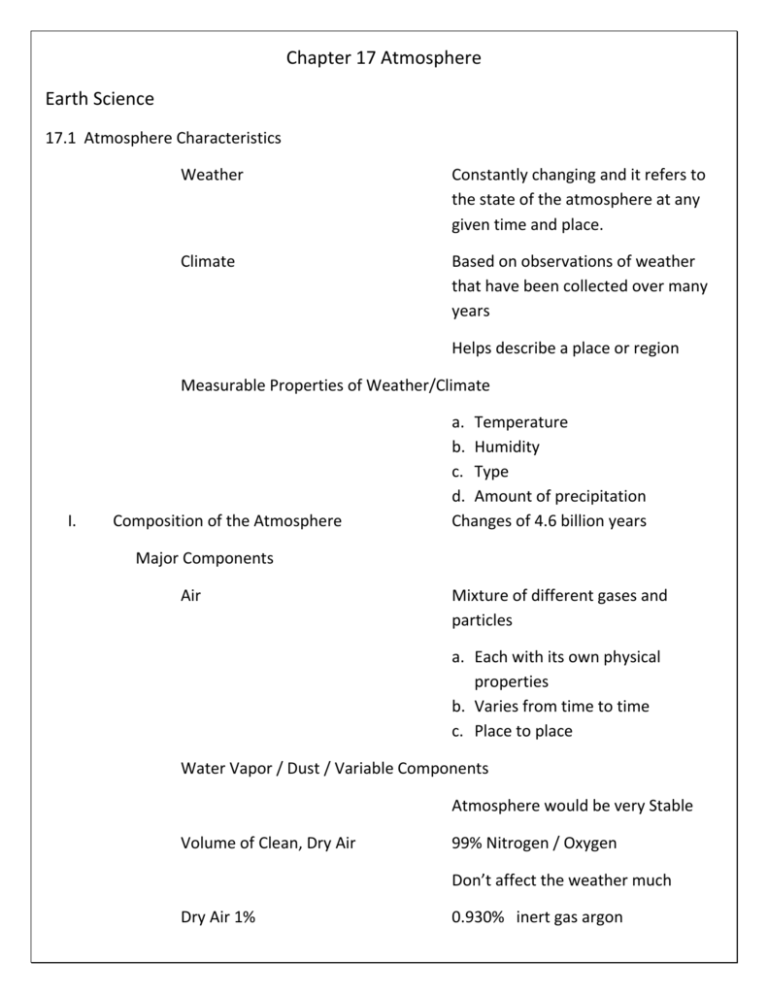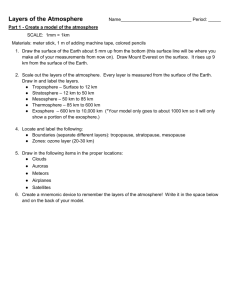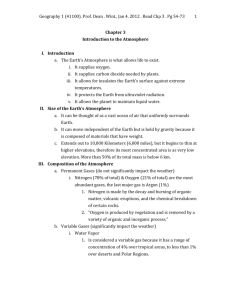Chapter 17 Atmosphere Earth Science 17.1 Atmosphere
advertisement

Chapter 17 Atmosphere Earth Science 17.1 Atmosphere Characteristics Weather Constantly changing and it refers to the state of the atmosphere at any given time and place. Climate Based on observations of weather that have been collected over many years Helps describe a place or region Measurable Properties of Weather/Climate I. Composition of the Atmosphere a. Temperature b. Humidity c. Type d. Amount of precipitation Changes of 4.6 billion years Major Components Air Mixture of different gases and particles a. Each with its own physical properties b. Varies from time to time c. Place to place Water Vapor / Dust / Variable Components Atmosphere would be very Stable Volume of Clean, Dry Air 99% Nitrogen / Oxygen Don’t affect the weather much Dry Air 1% 0.930% inert gas argon 0.039% carbon dioxide 0.031% number of other gases Variable Components Water Vapor Varies from 0 – 4% a. Source of all clouds and precipitation b. Absorbs heat given off by Earth c. Absorbs some solar energy Ozone Form of oxygen that combines 3 oxygen atoms into each molecule a. Very little ozone in the atmosphere b. Concentrated layer 10 – 50 km above the Earth’s surface ***If ozone did not filter most UV radiation and all of the sun’s UV rays reached the surface of Earth, our planet would be uninhabitable for many living organisms. Human Influence Air Pollutants Airborne particles and gases that occur in concentrations large enough to endanger the health of organisms. Primary Pollutants Emitted directly from identifiable sources Ex. Cars, trains, factories, Secondary Pollutants Not emitted directly into the air a. Form in atmosphere – reactions take place among primary pollutants and other substances II. Height and Structure of the Atmosphere **Atmosphere thins as you travel away from Earth until there are too few gas molecules to detect Pressure Changes The weight of the air above the Earth a. Sea level – Average Pressure 1000 millibars Temperature Changes 1. Troposphere Atmosphere can be divided vertically into four layers Bottom layer decreases with an increase in altitude a. Thickness is not the same everywhere b. Temperature drops to the height of 12 km Tropopause Outer boundary of troposphere Height of 12 km 2. Stratosphere Beyond tropopause a. Temperature remains constant to a height of 20 km b. Gradual increase in temperature until stratopause c. Stratosphere is heated at this height due to absorbtion of ultraviolet radiation Stratopause 3. Mesophere Increase temperature up to 50 km Temperatures decrease with height until mesopause Mesopause 4. Thermosphere ^ 80 km above the Earth / temperatures reach -98* C no well-defined upper limit Temperatures increase because oxygen / nitrogen absorb short-wave high energy solar radiation III. Earth-Sun Relationships Earth’s Motions Rotation – Spinning of Earth about its axis a. Imaginary line through north and south pole b. Earth rotates 1 every 24 hrs – cycle of daylight/darkness Revolution – Movement of Earth in its orbit around the sun a. Travels 113,000 km per hour in ellipitical orbit Earth’s Orientation Seasonal changes occur because Earth’s position relative to the sun continually changes as it travels along its orbit. Summer Soltice June 21, 22 First official day of the summer Winter Soltice December 21, 22 First day of winter Autumnal Equinox September 22, 23 Spring Equinox March 22, 23 **All in the Northern Hemisphere









